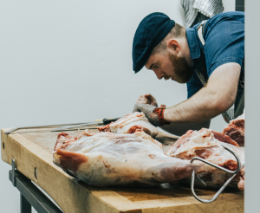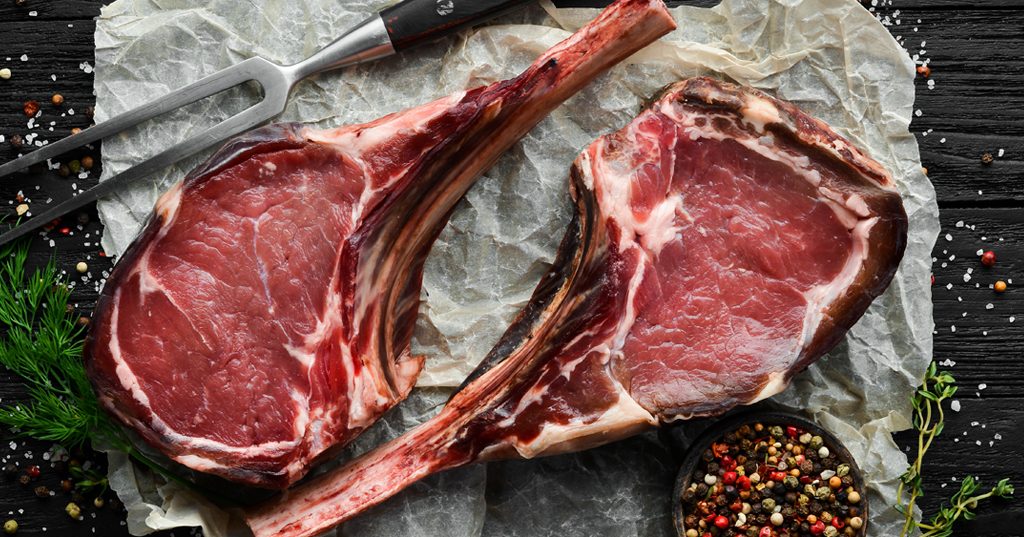When it comes to buying steak, it can be a bit of a minefield to know what’s best.
“28-day matured”.
“Grass-fed 21 day-aged”
“Dry-aged for 28 days on the bone”
Throw in the breed name and whether it’s organic or not and you’re sure to be confused as to what’s going to taste best on your plate.
So, what does all of this actually mean? Is a 35-day matured steak better than a 21-day dry-aged steak? What is dry-ageing, and more importantly why is dry aged steak better?
What is dry ageing?
To begin, it’s good to understand more about the process itself.
Dry ageing is a centuries-old method for improving the flavour and texture of beef. A carcass is hung to rest before it’s prepared and eaten, improving both the flavour and texture of the meat.
Nearly all beef is aged for tenderness, as the first 7-10 days of this resting process are extremely important for the initial muscle breakdown to occur.
During the second week of ageing, tenderness improves massively as natural enzymes in the muscle and connective tissues start to relax and break down the meat.
Beyond this 2-week period, the main benefit of the process is then to improve the flavour, as the tenderisation only improves slowly after this time.
All our beef goes through this initial 1 week ageing process. With the slow cook or braising cuts not needing any further maturation, as they are aided by the cooking process and are ready to be enjoyed. Then the roasting joints and steaks continue to be dry-aged further to build that delicious beefy flavour that you expect.
We’ll age our roasting joints for around another week, but our steaks are where we use dry ageing to its full potential. Rib-eye, tomahawk, rump, and sirloin steaks take on their wonderful, rich flavour at around 21 days and can be aged for 28 to 35 days or longer to keep building intensity. We’ve once aged a cut for 3 months!
But it’s more than just time that’s important.
Without fat, the dry-ageing process doesn’t work. Fat is what adds the flavour. It’s also what protects the meat from spoiling as it ages.
It’s the reason a rib-eye steak is aged for much longer than a fillet steak.
Fillet steak is a lean cut. There’s little fat within the meat itself or surrounding it. Once it’s tenderised, further ageing would only dry out the steak and discolour it, eventually spoiling it completely.
A rib-eye cut however is marbled with and surrounded by fat. This means the ageing process can go on for longer as the fat protects the meat from the moisture that fuels bacteria growth and would spoil the meat. And the longer it’s aged, the more the fat will develop into a rich, beefy flavour.
And there are plenty more important factors…
The temperature at which the meat is aged is vital. A couple of degrees difference can have a huge impact. Too cold and there’s a risk ice will form in the meat that would break it up. Too warm and there’s a risk of accelerating bacteria growth.
Moisture levels must be kept low and there must be a good circulation of air to seal the meat. Lean meat exposed to moisture will easily spoil.
Experience is vital too. It’s not a one-size-fits all process. Every piece of meat ages differently. And much like a cheesemaker would regularly check a maturing cheese, each cut is regularly checked and tested throughout to select it at its best.
And of course, all of this doesn’t work if the meat itself isn’t the best it can be in the first place.
Poor quality meat just doesn’t age well. Often the meat is older and tougher to start with. And sadly, this is often the meat used for those disappointing cheaper steaks.
Instead, meat that is the cream of the crop, and that has the very best fat content will benefit the most from dry ageing.
Meat that’s come from animals of a good age, that have eaten the right food, and that have had a good life without stress, produce exceptional meat that’s perfect for dry ageing.
So, whether it’s rib-eye for a special occasion, tender, juicy tomahawk for your BBQ, or a rich, flavoursome rump steak sandwich, by buying the best you can afford and cooking it well you can be sure of the best tasting steak every time.





